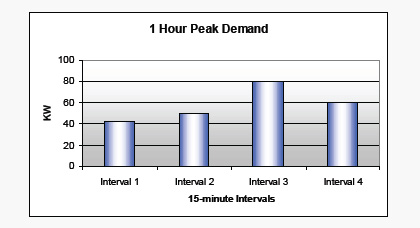Why Should You Care about Demand?
June 2011
 |
Most of the time our attention is focused on areas that directly effect us or have a significant impact on our lives - it’s human nature. There are so many factors pulling our attention in different directions with our hectic day-to-day schedules that Demand is probably the last thing on our minds. So why should you take 5 minutes out of your busy day to read this article...
|
Refresher on TermskWh is ENERGY which is the amount of electricity consumed | |
Electric RatesYour electric bill is the most relevant area demand appears. You’ve probably seen the word “demand” listed on your electric bill. What is it and what does it mean? Good question — you’re not alone. For most commercial customers and some residential customers (depending on the utility) there is a portion of the electric bill called a Demand Charge. The Demand Charge is the amount you are charged, per kW, for your highest demand during the billing month. Your highest demand during the billing month is called the “Peak Demand” and this determines not only your Demand Charge but also what rate you will be placed on by the utility. |
|
|
There are three basic rate classes:
For this explanation we will focus on SGS and MGS. |
In most cases, the SGS rate has the demand charge embedded within the kWh charge, so there’s no separate demand charge on your bill. MGS rates have the regular kWh charge plus a separate demand charge. So for some businesses, the goal is to stay below the threshold between rates, usually about 25kW. If your peak demand is lower than the threshold, you can remain on the SGS rate. If you’re on the MGS rate, however, the goal is to lower your demand charge by keeping your peak demand minimized. Either way, the objective is to obtain lower total costs on your electric bills. |
|
Peak DemandMost utilities divide your electric use into 15-minute intervals. The meter records your kWh use for each of those 15-minute intervals. The interval with the highest 15-minute usage (in that billing period) sets your peak demand for that month. In an average 1-month billing period, you have about 3,000 opportunities to set the peak demand. |
|
ExampleThis table shows one hour of electric use — only 4 of 3,000 intervals in a typical month/billing period. As you can see, 80kW winds up being the Peak Demand out of these four 15-minute intervals. |
|
ExampleThis graph shows the kWh use from the table above. |
|
ExampleThis graph shows kW from the table above. As you can see Interval 3 has the highest kW determining the Peak Demand to be 80kW out of these four intervals. |
|
Take-AwayEven if you stayed well below the 25kW threshold for 2,999 15-minute intervals, and only went over 25kW for one interval, you would still be moved to the MGS rate and pay demand charges. Many utilities require you to be below the threshold for 6 months or even a year before they move you to the lower SGS rate. If you are on the MGS rate and far from the threshold, the goal then becomes to get your peak demand as low as possible. By lowering your peak demand you will lower your demand charge (cost per kW), thus lowering your electric bills. It’s very important to know your demand in order to remain on the desired rate and/or save money on your electric costs. Contact your utility provider to see if moving to a lower rate, or reducing your kW will save you money. If so, an Energy Sentry demand management system can help manage your electric loads to lower your peak demand and reduce your electric bills. | |
If you are interested in learning more about Energy Sentry demand management systems, contact the experts at Brayden Automation Corp. (888) 272-9336.



